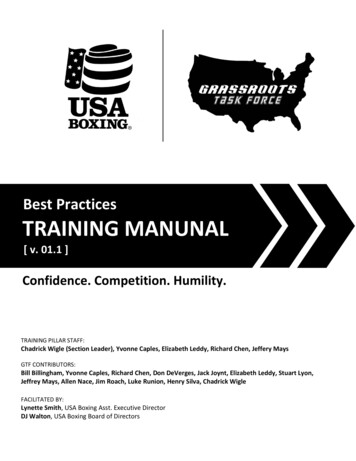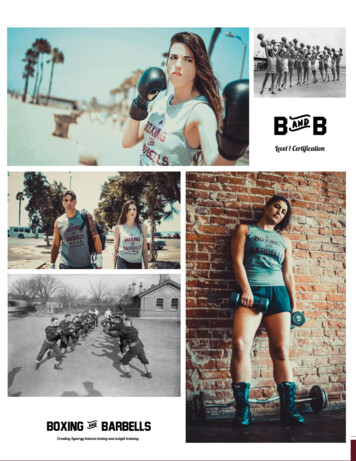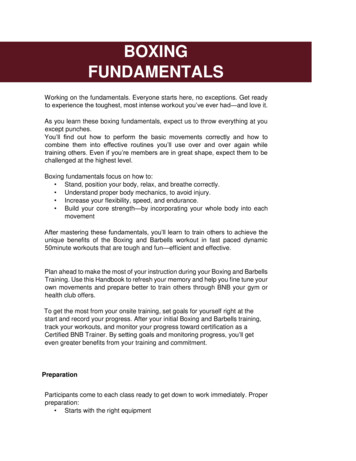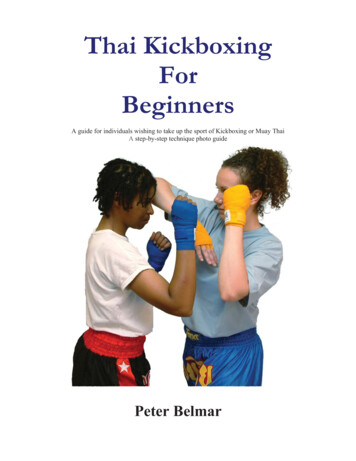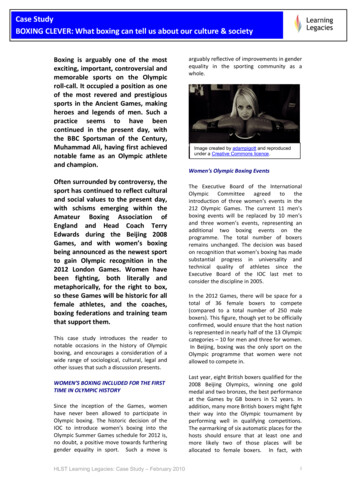
Transcription
Case StudyBOXING CLEVER: What boxing can tell us about our culture & societyBoxing is arguably one of the mostexciting, important, controversial andmemorable sports on the Olympicroll-call. It occupied a position as oneof the most revered and prestigioussports in the Ancient Games, makingheroes and legends of men. Such apractice seems to have beencontinued in the present day, withthe BBC Sportsman of the Century,Muhammad Ali, having first achievednotable fame as an Olympic athleteand champion.Often surrounded by controversy, thesport has continued to reflect culturaland social values to the present day,with schisms emerging within theAmateur Boxing Association ofEngland and Head Coach TerryEdwards during the Beijing 2008Games, and with women’s boxingbeing announced as the newest sportto gain Olympic recognition in the2012 London Games. Women havebeen fighting, both literally andmetaphorically, for the right to box,so these Games will be historic for allfemale athletes, and the coaches,boxing federations and training teamthat support them.This case study introduces the reader tonotable occasions in the history of Olympicboxing, and encourages a consideration of awide range of sociological, cultural, legal andother issues that such a discussion presents.WOMEN’S BOXING INCLUDED FOR THE FIRSTTIME IN OLYMPIC HISTORYSince the inception of the Games, womenhave never been allowed to participate inOlympic boxing. The historic decision of theIOC to introduce women’s boxing into theOlympic Summer Games schedule for 2012 is,no doubt, a positive move towards furtheringgender equality in sport. Such a move isHLST Learning Legacies: Case Study – February 2010arguably reflective of improvements in genderequality in the sporting community as awhole.Image created by adampigott and reproducedunder a Creative Commons licence.Women’s Olympic Boxing EventsThe Executive Board of the on of three women’s events in the212 Olympic Games. The current 11 men’sboxing events will be replaced by 10 men’sand three women’s events, representing anadditional two boxing events on theprogramme. The total number of boxersremains unchanged. The decision was basedon recognition that women’s boxing has madesubstantial progress in universality andtechnical quality of athletes since theExecutive Board of the IOC last met toconsider the discipline in 2005.In the 2012 Games, there will be space for atotal of 36 female boxers to compete(compared to a total number of 250 maleboxers). This figure, though yet to be officiallyconfirmed, would ensure that the host nationis represented in nearly half of the 13 Olympiccategories – 10 for men and three for women.In Beijing, boxing was the only sport on theOlympic programme that women were notallowed to compete in.Last year, eight British boxers qualified for the2008 Beijing Olympics, winning one goldmedal and two bronzes, the best performanceat the Games by GB boxers in 52 years. Inaddition, many more British boxers might fighttheir way into the Olympic tournament byperforming well in qualifying competitions.The earmarking of six automatic places for thehosts should ensure that at least one andmore likely two of those places will beallocated to female boxers. In fact, with1
Case StudyBOXING CLEVER: What boxing can tell us about our culture & societynearly three years to go before the Londongames, British medal prospects lookparticularly bright in what will undoubtedly bea landmark women’s boxing competition. Forexample, bantamweight Nicola Adamsrecently won a silver medal at the WorldChampionshipsinChina,andlightwelterweight Natasha Jonas also sits high inthe world rankings.Creating Boxing StarsRobert McCracken, British Boxing's newPerformance Director has commented that interms of the British Olympic squad: "Theability is there, no doubt about it.” He went onto comment of the glory of Olympiccompetition being a significant draw to youngfighters: "For any young fighter, that has gotto be an amazing reward if they work hardenough at boxing Also, as we have seen inthe past, Olympics can turn fighters into starsalmost overnight."From illegal to Olympic, in only 20 years: AHistory of Women’s Boxing.Jane Couch is not only one of our mostformidable and successful multiple-Worldchampion boxers; she can be credited, quitepossibly, for changing the face of women’sboxing forever. Bristol-based Couch fought along legal battle with the British Boxing Boardof Control (BBBC), nearly 20 years ago, tobecome the first woman in this country toobtain a license to fight professionally inBritain. At the time, she was not allowed tofight in her own country, simply because ofher gender. Couch was supported in her sh promoter Frank Maloney, trainer toLennox Lewis, exhibited significant disdain anddiscriminatory feelings with regard towomen’s rights to box, commenting to theBBC that: "The only reason for women to be inthe ring is as ring card girls." Such commentsreflected a common view that womenshouldn’t fight – a stark difference fromtoday’s conceptualisation, where the searchfor female boxing talent is now a key featureof British Boxing’s strategy for the acquisitionof Gold medals at the 2012 Games.HLST Learning Legacies: Case Study – February 2010Jane Couch is now a five times World Titlechampion and also a licensed promoter, and isactively involved in helping to develop thewomen’s side of the sport.A General History of Boxing in the Ancientand Modern GamesAccording to ancient mythology, Apollo wasthe inventor of boxing. The sport first featuredin the Ancient Games in 688 BC, rendering itone of the oldest sports in Olympic history.Classical scholars will note that the sport ofboxing featured notably in Homeric poems.The sport was far more violent in its’ ancientguise, when compared to the modern dayversion. In Ancient times, himantes, or strapsof soft ox-hide, were used in place of gloves;the purpose of this was to strengthen thewrist and steady the fingers. The himanteswere wrapped around the first knuckles of thefingers, leaving the thumb uncovered. In laterGames, straps of hard leather were addedaround the knuckles of the fingers to enhancethe strength and impact of punches.We can observe a transition towards the gloveththat we recognise today from the 4 CenturyBC, when a form of glove replaced thehimantes, principally to avoid the timeconsuming nature of application of thehimantes. The "oxeis himantes" (sharp thongs)were formed of hard leather straps and aninner layer of wool was included to protectthe hand. The later Roman invention of thecaestus further transformed the sport, whichconsisted of a boxing glove which wasreinforced with iron and lead.Such an adaptationradically transformed analready violent sportinto a brutal and deadlyexchange, and might tellus a great deal aboutthe sociologies of bothcultures with respect tosport and its role.Image created by DrJohn2005 and reproducedunder a CreativeCommons licence.2
Case StudyBOXING CLEVER: What boxing can tell us about our culture & societyModern GamesOlympic boxing is one of the oldest and mostpopular Summer Olympic sports, firstappearing in the modern Games in 1904 in St.Louis. It courted controversy almostimmediately, with Australia's Reginald"Snowy" Baker lodging a complaint at the1908 London Games, complaining that thereferee for his fight (which he lost) was notimpartial. It was quite possible that he wasright - his opponent’s father was the referee!Fighting controversies were to continue at thenext quadrennial event, with the sport beingbanned from the 1912 Stockholm Games (thesport was banned in Sweden at that time).The sport returned successfully in 1920, andhas never looked back. Today it retains animage as one of the most exciting andcontroversial sports on the world stage.Title taken from him by the authorities, winthe BBC Sports Personality of the Year, returnto the Olympic family as a torch bearer,undertake extensive charity work across theglobe and inspire countless young people tobe better people in sport and in life.Mexico City, 1968: The world first met GeorgeForeman, future World Champion (andmastermind of the popular George ForemanGrill!) A patriotic 19-year-old Foreman wonthe heavyweight Gold medal and thenparaded around the ring with a tiny Americanflag, forever winning the hearts of theAmerican public as he did so.Montreal, 1976: Sugar Ray Leonard, one ofthe greatest fighters in modern day historymade his debut, fighting with photos of hisgirlfriend and young son pinned to his socks,.He became the light welterweight Gold medalchampion and then began an extremelysuccessful and memorable pro career.Athens 2004Image created by crashmaster007 andreproduced under a Creative Commons licence.Of course, no British boxing fan could forgetthe great Silver medal-winning performanceof Amir Khan. Despite losing in the Olympicfinal to Cuban Mario Kindelan, Khan avengedhis loss in 2005 by beating the 34 year oldKindelan in his last amateur fight. Khan wenton to pursue a successful pro career.The Structure of the SportBeijing 2008An Olympic Boxing bout consists of four twominute rounds. The winner of each weightclass wins an Olympic gold medal. Somenotable and historic boxing champions firsttook the stage at the Olympics:Rome, 1960: The world was introduced to oneof the greatest sportsmen in history:Muhammad Ali, then known as Cassius Clay.At only 18 years of age, a young Ali won thelight-heavyweight Gold medal. He was later tosymbolically throw his Olympic medal into ariver, disillusioned at the racial discriminationpresent in his country. He went on to becomea world champion, join the Nation of Islam,engage in legal battle with the USGovernment over his conscientious objectionto fighting in the Vietnam War, have his WorldHLST Learning Legacies: Case Study – February 2010The most recent Summer Games identifiedserious schisms within the British boxingcamp. When James de Gale bought home aGold medal for his country, he took the postvictory interview as an opportunity to praisehis coach Terry Edwards, and to criticise thegoverning body for the sport for what heviewed as disrespectful treatment of a coachwho he personally greatly respected.MEDICAL BANSome members of the medical fraternity havesought to implement a ban on boxing, viewingit as too violent. Whilst the injury rates ofboxing fall far short of many other sports, theBritish Medical Association argue that thelong-term brain injury of boxers goes largely3
Case StudyBOXING CLEVER: What boxing can tell us about our culture & societyunrecorded, so still poses a significant danger.Such an argument could form the basis of aninteresting ‘philosophy of science’ debate: ifone cannot empirically test such a claim,should it ever be used to form the rationalefor banning a sport? How could we knowwhether such a claim could be true? Is it evenpossible to measure such a concept? It iscertain that such a debate could rumble on forthe foreseeable future.SOCIAL INCLUSION INITIATIVESAmateur boxing forms the basis of somesuccessful and well-regarded social inclusionprogrammes. A good example is the inclusionof boxing in recent government initiativessuch as Positive Futures. The Fight for Peaceuse of boxing in its’ sport and educationmodel is another highly successful example ofthe use of sport as a social inclusion initiative.Founder of Fight for Peace, Luke Dowdney,won a MBE and a Laureus Sport for GoodAward for his work in this field, and nowcounts former and current boxing superstarssuch as Barry McGuigan and VladimirKlitschko as trustees of the organisation.It must be noted that key proponents of thesport and social inclusion model favour thedual use of sport and education, as opposedto the singular use of sport, as the mostefficient means of engaging young at-riskindividuals (as opposed to the use of the sportalone).both the mental and physical accuity of theathlete. This is an interesting move forwardfor a sport that could in fact be conceptualisedas a very violent game of Chess, due to itssignificant reliance on both tacticalstrategising and physical accuity!The sport may have many detractors as wellas fans, but one thing cannot be denied:boxing could never be boring. It remains to beseen which direction such a fundamentallyhistoric, controversial and exciting sport willtake us next!FIND OUT MOREFight for Peacehttp://www.fightforpeace.net/home.phpBritish Boxing Board of Controlwww.bbbofc.com/Amateur Boxing Association of Englandwww.abae.co.ukBOXING: THE FUTURE?The medical debate surrounding the safety ofthe sport continues to rage on, whilst newforms of the sport have begun to emerge.White collar boxing is a relatively new butgrowing side of the sport, where corporateexecutives trained by ABAE coaches sign up tofight each other at white collar sponsoredevents (often raising money for charity in theprocess). This possibly reflects the corporatemyth that sport has something to teachbusiness in terms of the development ofcharacter (mental toughness, self-leadership,courage, discipline, etc). Chessboxing is thenewest incarnation of the sport, which testsHLST Learning Legacies: Case Study – February 20104
Case StudyBOXING CLEVER: What boxing can tell us about our culture & societyCREDITS Oxford Brookes University 2010. oxb:060111:000csThis resource was produced as part of the 2012 Learning Legacies Project managed by the HEAHospitality, Leisure, Sport and Tourism Subject Centre at Oxford Brookes University and was releasedas an Open Educational Resource. The project was funded by HEFCE and part of the JISC/HE AcademyUKOER programme. Except where otherwise noted above and below, this work is released under aCreative Commons Attribution only licence.Exceptions to the LicenceThe name of Oxford Brookes University and the Oxford Brookes University logo are the name andregistered marks of Oxford Brookes University. To the fullest extent permitted by law Oxford BrookesUniversity reserves all its rights in its name and marks, which may not be used except with its writtenpermission.The JISC logo is licensed under the terms of the Creative Commons Attribution-Non-Commercial-NoDerivative Works 2.0 UK: England & Wales Licence. All reproductions must comply with the terms ofthat licence.The Higher Education Academy logo and the HEA Hospitality, Leisure, Sport and Tourism SubjectCentre logo are owned by the Higher Education Academy Limited and may be freely distributed andcopied for educational purposes only, provided that appropriate acknowledgement is given to theHigher Education Academy as the copyright holder and original publisher.Reusing this workTo refer to or reuse parts of this work please include the copyright notice above including the serialnumber. The only exception is if you intend to only reuse a part of the work with its own specificcopyright notice, in which case cite that.If you create a new piece of work based on the original (at least in part), it will help other users to findyour work if you modify and reuse this serial number. When you reuse this work, edit the serialnumber by choosing 3 letters to start (your initials or institutional code are good examples), changethe date section (between the colons) to your creation date in ddmmyy format and retain the last 5digits from the original serial number. Make the new serial number your copyright declaration or addit to an existing one, e.g. ‘abc:101011:000cs’.If you create a new piece of work or do not wish to link a new work with any existing materialscontained within, a new code should be created. Choose your own 3-letter code, add the creationdate and search as below on Google with a plus sign at the start, e.g. ‘ tom:030504’. If nothingcomes back citing this code then add a new 5-letter code of your choice to the end, e.g.; ‘:01lex’, anddo a final search for the whole code. If the search returns a positive result, make up a new 5-lettercode and try again. Add the new code your copyright declaration or add it to an existing one.HLST Learning Legacies: Case Study – February 20105
introduction of three women [s events in the 212 Olympic Games. The current 11 men [s boxing events will be replaced by 10 men [s and three women [s events, representing an additional two boxing events on the programme. The total number of boxers remains unchanged. The decision was based on recognition that women [s boxing has made

